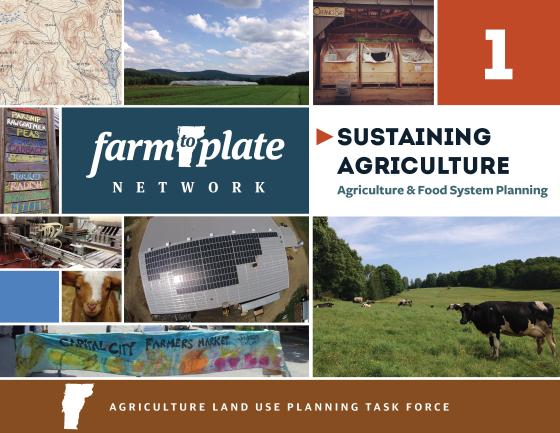Posted November 10, 2014 at 11:17am by
Vermont agricultural land use planning guide available for local and regional planners

A series of agricultural land use planning modules are now available as a resource for land use planners on such topics as farmland conservation, farm and property taxes, commercial composting, agritourism, and food system planning. The planning guide is a project of the Vermont Farm to Plate Initiative’s Agricultural Land Use Planning Task Force. Municipal officials, local and regional planning commissions, and agriculture advocates will be able to use the modules to guide land use planning for farmland, including ways to update zoning regulations that can sustain and spark more agricultural economic activity in Vermont communities.
Two years ago the task force identified the need to update the well-known planning guide, Sustaining Agriculture, published by the Vermont Agency of Agriculture in 1994. “As Vermont’s local food movement quickened the pace of agri-preneurial development, it became clear there was a need for an update to the original guide that expanded on the topics covered in the original 1994 print guide. The new modules demonstrate how the entire food system can be incorporated into town planning by addressing issues in agriculture that have to date not been extensively covered like commercial composting and food system planning, while giving detailed guidance on historically important issues like farmland conservation, farmland and taxes, and land use regulations,” states Peg Elmer, chair of the Farm to Plate Agricultural Land Use Planning Task Force and principal of Community-Resilience.org.
The Farm to Plate Agricultural Land Use Planning Task Force is comprised of the Central Vermont Regional Planning Commission, Community-Resilience.org, Composting Association of Vermont, Lamoille County Planning Commission, Northeastern Vermont Development Association, Vermont Agency of Agriculture, Food and Markets, Vermont Housing and Conservation Board, Vermont Natural Resources Council, and several land planning consultants.
The updated planning guide will pointedly help Vermont achieve the Farm to Plate Strategic Plan’s goal to ensure agricultural lands and soils will be available, affordable, and conserved for future generations of farmers while meeting the needs of Vermont’s food system.
“Development pressure continues to put farmland in danger of being converted to non-agricultural uses and planners need to be equipped with the tools and knowledge to effect land-use patterns that strengthen and conserve Vermont’s agricultural resources,” says Jake Claro, Farm to Plate project manager. “Additionally, as farms diversify their operation, particularly events-based businesses like weddings or burger nights, local zoning regulations need to keep pace with these changes in a way that doesn’t stifle innovation, but adequately deals with public concerns.”
The agricultural land use planning guide has been broken into five modules and each can be accessed and downloaded from the Farm to Plate website at: bit.ly/VTAgLandGuide.
###
Vermont Farm to Plate is the statewide initiative legislatively directed to increase economic development and jobs in Vermont’s farm and food sector and improve access to healthy local food for all Vermonters. The ten year Farm to Plate Strategic Plan to strengthen the working landscape, build the resilience of farms and food enterprises, improve environmental quality, and increase healthy, local food access for all Vermonters is being implemented by the Farm to Plate Network—over 350 farm and food sector organizations from across the state. Farm to Plate is coordinated by the Vermont Sustainable Jobs Fund, a non-profit organization based in Montpelier, Vermont. Learn more at www.VTFarmtoPlate.com.
